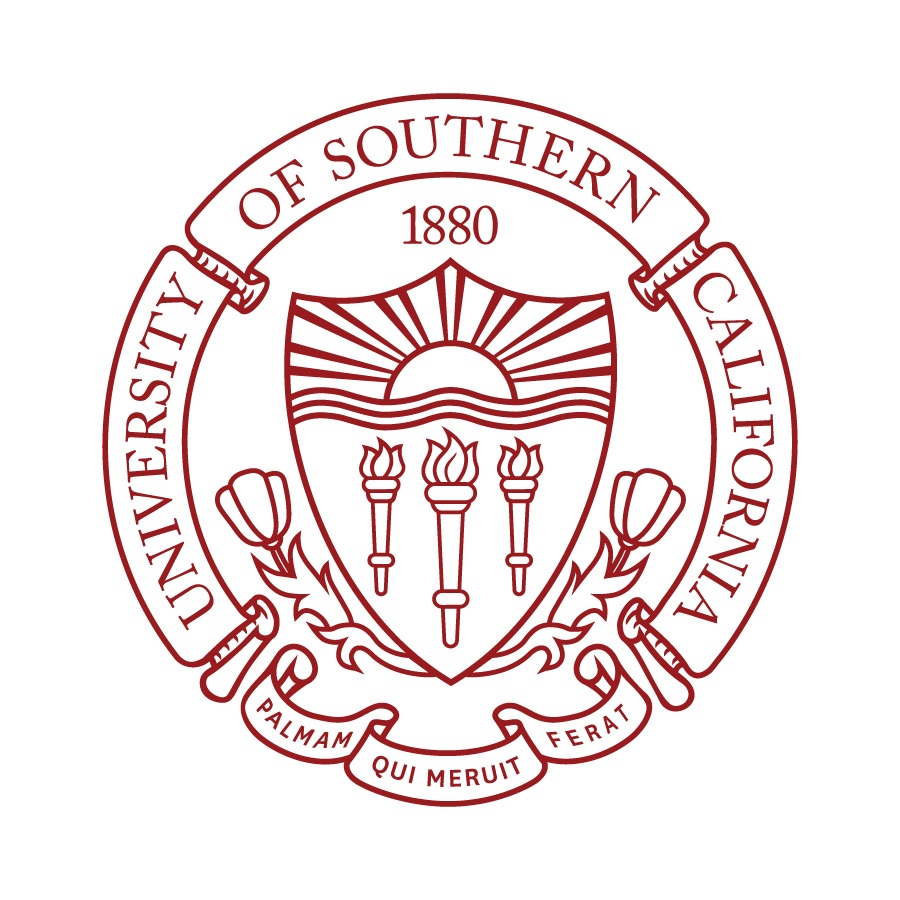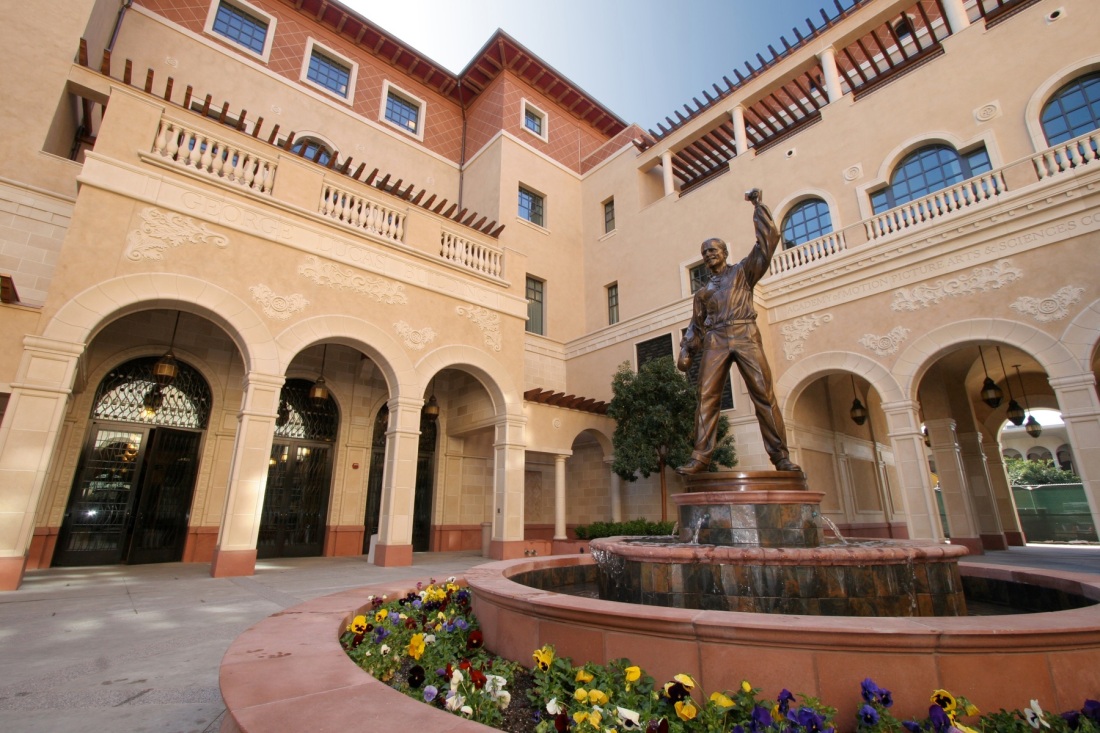From The Dornsife College of Letters Arts and Sciences
At
The University of Southern California
Via
6.19.24
Harry Baker
A new study confirms that Earth’s inner core has been rotating more slowly than usual since 2010. This mysterious “backtracking” could also end up slightly altering the planet’s overall rotation, lengthening our days.
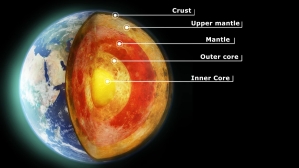
The heart of our planet has been spinning unusually slowly for the past 14 years, new research confirms. And if this mysterious trend continues, it could potentially lengthen Earth’s days — though the effects would likely be imperceptible to us.
Earth’s inner core is a roughly moon-size chunk of solid iron and nickel that lies more than 3,000 miles (4,800 kilometers) below our feet. It is surrounded by the outer core — a superhot layer of molten metals similar to those in the inner core — which is surrounded by a more solid sea of molten rock, known as the mantle, and the crust. Although the entire planet rotates, the inner core can spin at a slightly different speed as the mantle and crust due to the viscosity of the outer core.
Since scientists started mapping Earth’s inner layers with detailed seismic activity records around 40 years ago, the inner core has rotated slightly faster than the mantle and the crust. But in a new study, published June 12 in the journal Nature, researchers found that since 2010, the inner core has been slowing down and is now rotating a bit more slowly than our planet’s outer layers.
Fig. 1: Seismic ray paths and event locations.

a, Ray paths of PKIKP and PKP from the SSI source region to the two arrays (ILAR and YKA). The sampled IC region with a representative 1.5 Hz Fresnel zone 30* is marked with dashed circles centred at the PKIKP pierce points at the ICB. Inset, the ray paths of PKP (PKP(AB) and PKP(BC)), PKiKP(CD) and PKIKP(DF). b, Map of the SSI region with the source locations coloured by focal depth.
*Science paper reference.
Fig. 2: Waveform comparison of multiplets.
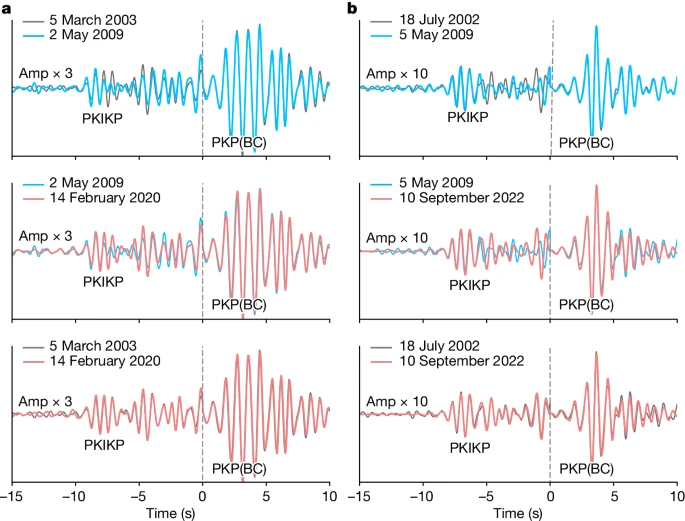
a, The triplet that forms multiplet O, which repeats in 2003, 2009 and 2020. b, The triplet that forms multiplet J, which repeats in 2002, 2009 and 2022.
See the science paper for further instructive material with images.
“When I first saw the seismograms that hinted at this change, I was stumped,” John Vidale, a seismologist at the University of Southern California, Dornsife, said in a statement. “But when we found two dozen more observations signaling the same pattern, the result was inescapable.”
If the inner core’s rotation continues to decelerate, its gravitational pull could eventually cause the outer layers of our planet to spin a little more slowly, altering the length of our days the researchers wrote.
However, any potential change would be on the order of thousandths of a second, which would be “very hard to notice,” Vidale said. As a result, we would likely not have to change our clocks or calendars to adjust for this difference, especially if it were only a temporary change.
This is not the first time scientists have suggested that Earth’s inner core is slowing down. This phenomenon, known as “backtracking,” has been debated for around a decade but has been very hard to prove.
In the new study, researchers analyzed data from more than 100 repeating earthquakes — seismic events that occur repeatedly at the same location — along a tectonic plate boundary in the South Sandwich Islands in the South Atlantic Ocean between 1991 and 2023.
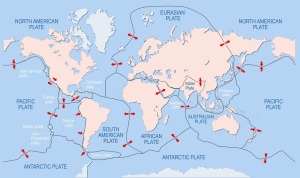
Each earthquake allowed scientists to map the core’s position relative to the mantle and by comparing these measurements, the team was able to see how the inner core’s rotation rate changed over time.
The new study is the “most convincing” evidence so far that backtracking has been happening, Vidale said.
It is currently unclear why the inner core is backtracking, but it is likely caused by either “the churning of the liquid iron outer core that surrounds it” or “gravitational tugs from the dense regions of the overlying rocky mantle,” the researchers wrote.
It is also unclear how frequent backtracking is. It is possible that the inner core’s spin is constantly accelerating and decelerating, but these changes likely happen over decades or longer. Therefore, longer data sets are needed to infer anything about long-term trends.
The inner core remains one of the most mysterious of Earth’s hidden layers. But in recent years, new technologies are allowing researchers to learn more about the inner core, including that it is slightly lopsided, that it is softer than expected, that it potentially wobbles off Earth’s axis and that it has a separate innermost core.
The study authors will continue to analyze seismic data to learn more about the heart of our planet and how it changes over time.
“The dance of the inner core might be even more lively than we know,” Vidale said.
See the full article here .
Comments are invited and will be appreciated, especially if the reader finds any errors which I can correct.
five-ways-keep-your-child-safe-school-shootings
Please help promote STEM in your local schools.
The USC Dornsife College of Letters, Arts and Sciences is the academic core of the University of Southern California. Our diverse community works across the natural sciences, social sciences and humanities, exploring fundamental questions about who we are, how the world works, and what we can do to improve and enrich society.
Our faculty push the boundaries of knowledge and equip students with lifelong learning skills that enable them to overcome challenges of extraordinary social and technical complexity. Beyond the classrooms and laboratories, our scholars work hand-in-hand with leaders in the public and private sectors — bringing new ways of thinking to projects that call for their expertise.
Some of the most talented students in the world are attracted to USC Dornsife for its innovative courses and customizable degree programs. And because they are not content to wait until graduation to make an impact, every undergraduate takes part in hands-on experiential learning that converts thought to action.
Our USC Dornsife community values the insight we gain from our position in one of the most dynamic and diverse cities on Earth. Los Angeles is where cultures integrate, ideas are born, and trends are set. It is a place where global issues are expressed locally, allowing us to innovate the solutions here first.
The future belongs to creative thinkers. At the USC Dornsife College of Letters, Arts and Sciences, we enable their creativity to flourish.
The University of Southern California is a private research university in Los Angeles, California. Founded in 1880 by Robert M. Widney, it is the oldest private research university in California.
The university is composed of one liberal arts school, the Dornsife College of Letters, Arts and Sciences and twenty-two undergraduate, graduate and professional schools, enrolling an average of 19,500 undergraduate and 26,500 post-graduate students from all fifty U.S. states and more than 115 countries. USC is ranked among the top universities in the United States and admission to its programs is highly selective.
USC is a member of The Association of American Universities, joining in 1969. The University of Southern California houses professional schools offering a number of varying disciplines among which include communication, law, dentistry, medicine, business, engineering, journalism, public policy, music, architecture, and cinematic arts. USC’s academic departments fall either under the general liberal arts and sciences of the College of Letters, Arts, and Sciences for undergraduates, the Graduate School for graduates, or the university’s 17 professional schools.
USC was one of the earliest nodes on ARPANET and is the birthplace of the Domain Name System.

Other technologies invented at USC include DNA computing, dynamic programming, image compression, VoIP, and antivirus software.
USC’s notable alumni include Rhodes scholars and Marshall scholars. Nobel laureates, MacArthur Fellows, and Turing Award winners have been affiliated with the university. USC has conferred degrees upon billionaires, and has graduated more alumni who have gone on to win Academy and Emmy Awards than any other institution in the world by a significant margin, in part due to the success of the School of Cinematic Arts.
USC sponsors a variety of intercollegiate sports and competes in the National Collegiate Athletic Association (NCAA) as a member of the Pac-12 Conference. Members of USC’s sports teams, the Trojans, have won many NCAA team championships, ranking them very high in the United States, and many NCAA individual championships, ranking them very highly in the United States and among NCAA Division I schools. Trojan athletes have won many medals at the Olympic Games ( golds, silvers and bronzes), more than any other university in the United States. In 1969, it joined the Association of American Universities. USC has had many football players drafted to the National Football League.
The University of Southern California is the largest private employer in the Los Angeles area and generates an estimated $8 billion of economic impact on California.
Faculty and Research
The university is classified among “R1: Doctoral Universities – Very high research activity”. According to the National Science Foundation, USC spends over $900 million on research and development in 2018, ranking it very high in the nation.
USC employs approximately 4,800 full-time faculty, 1,900 part-time faculty, 17,000 staff members, and as many as 4,900 student workers. Over 350 postdoctoral fellows are supported along with over 800 medical residents. Among the USC faculty, a number are members of the National Academy of Sciences, the National Academy of Medicine, the National Academy of Engineering, the American Association for the Advancement of Science, the American Academy of Arts and Sciences, the American Philosophical Society, and the National Academy of Public Administration . Many USC faculty are listed as “Highly Cited” in the Institute for Scientific Information database. George Olah won the 1994 Nobel Prize in Chemistry and was the founding director of the Loker Hydrocarbon Research Institute. Leonard Adleman won the Turing Award in 2003. Arieh Warshel won the 2013 Nobel Prize in Chemistry.
The university also supports the Pacific Council on International Policy through joint programming, leadership collaboration, and facilitated connections among students, faculty, and Pacific Council members.
The university has two National Science Foundation–funded Engineering Research Centers: The Integrated Media Systems Center and the Center for Biomimetic Microelectronic Systems. The Department of Homeland Security selected USC as its first Homeland Security Center of Excellence. Since 1991, USC has been the headquarters of the NSF and USGS funded Southern California Earthquake Center (SCEC). The University of Southern California is a founding and charter member of CENIC, the Corporation for Education Network Initiatives in California, the nonprofit organization, which provides extremely high-performance Internet-based networking to California’s K-20 research and education community. USC researcher Jonathan Postel was an editor of communications-protocol for the fledgling internet, also known as ARPANET.
In July 2016 USC became home to the world’s most powerful quantum computer, housed in a super-cooled, magnetically shielded facility at the USC Information Sciences Institute, the only other commercially available quantum computing system operated jointly by National Aeronautics Space Agency and Google.
Notable USC faculty include or have included the following: Leonard Adleman, Richard Bellman, Aimee Bender, Barry Boehm, Warren Bennis, Todd Boyd, T.C. Boyle, Leo Buscaglia, Drew Casper, Manuel Castells, Erwin Chemerinsky, George V. Chilingar, Thomas Crow, António Damásio, Francis De Erdely, Percival Everett, Murray Gell-Mann, Seymour Ginsburg, G. Thomas Goodnight, Jane Goodall, Solomon Golomb, Midori Goto, Susan Estrich, Janet Fitch, Tomlinson Holman, Jascha Heifetz, Henry Jenkins, Thomas H. Jordan, Mark Kac, Pierre Koenig, Neil Leach, Leonard Maltin, Daniel L. McFadden, Viet Thanh Nguyen, George Olah, Scott Page, Tim Page (music critic), Simon Ramo, Claudia Rankine, Irving Reed, Michael Waterman, Frank Gehry, Arieh Warshel, Lloyd Welch, Jonathan Taplin, and Diane Winston.

